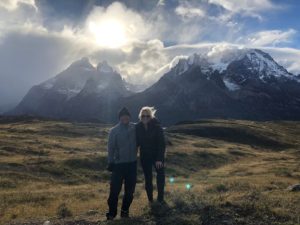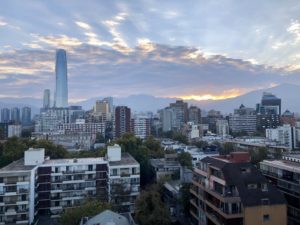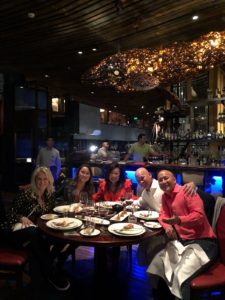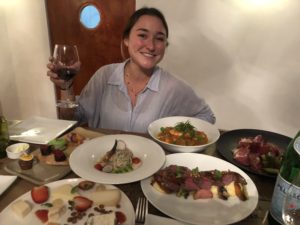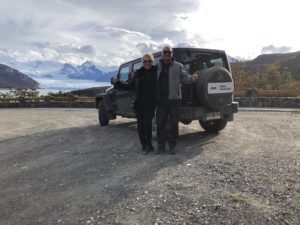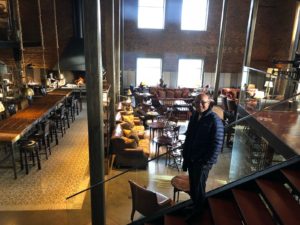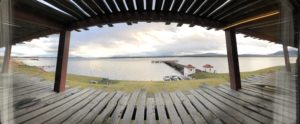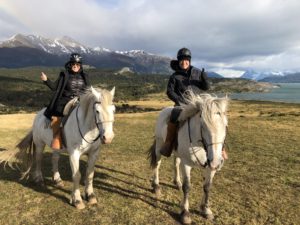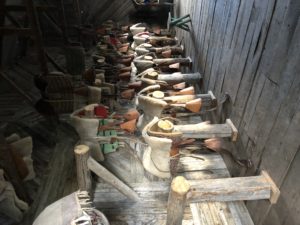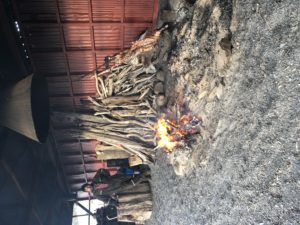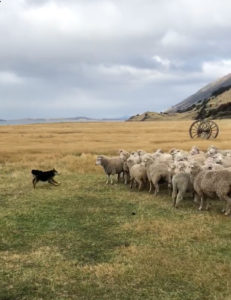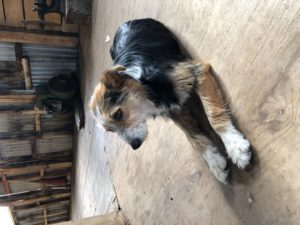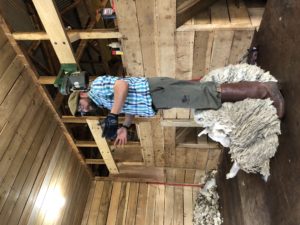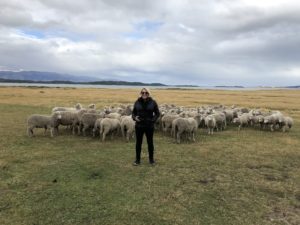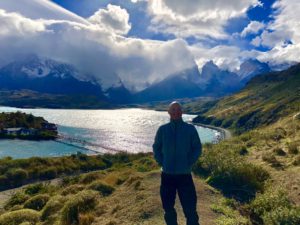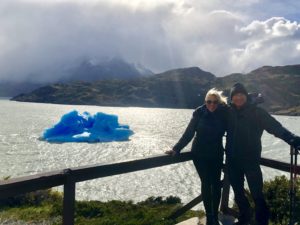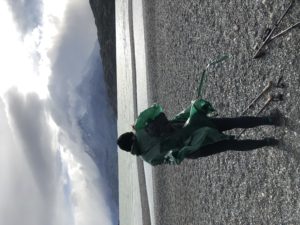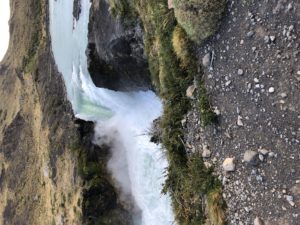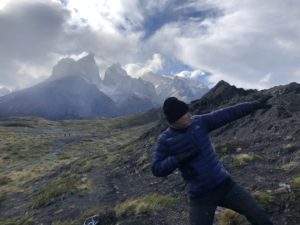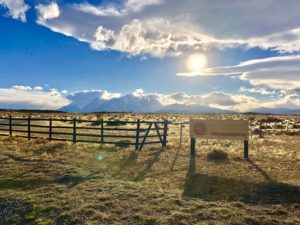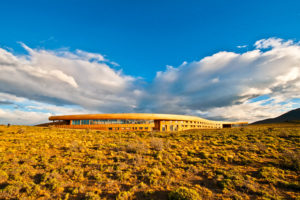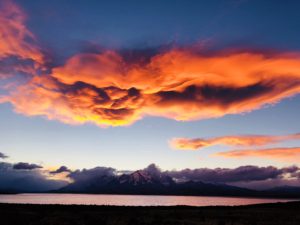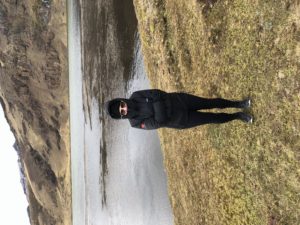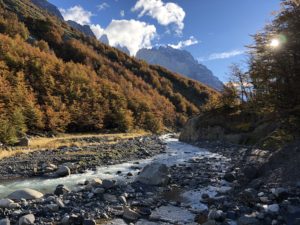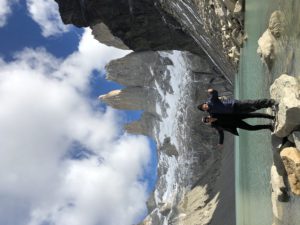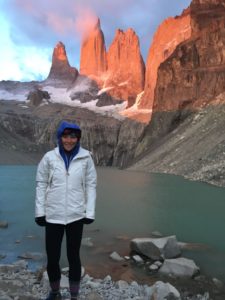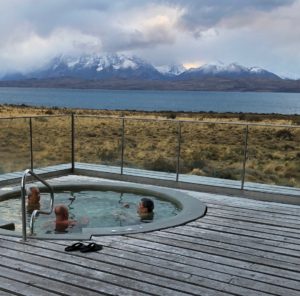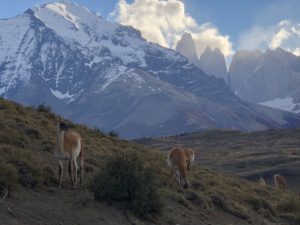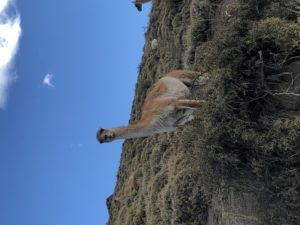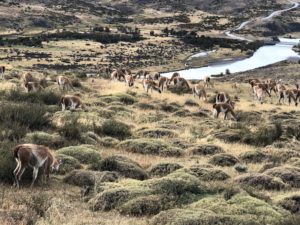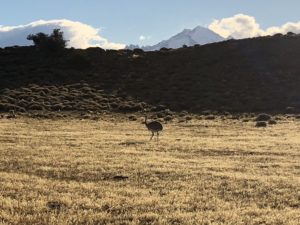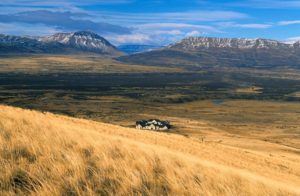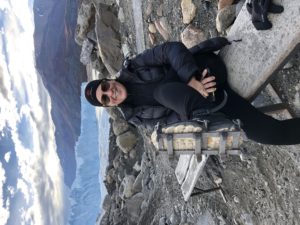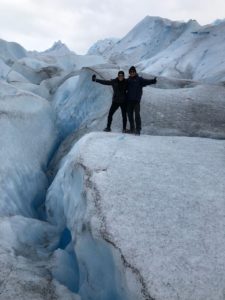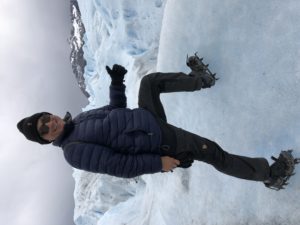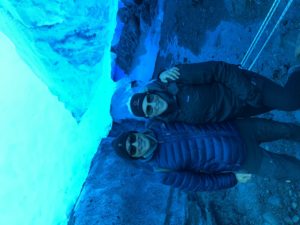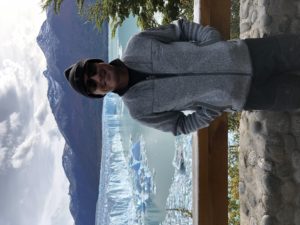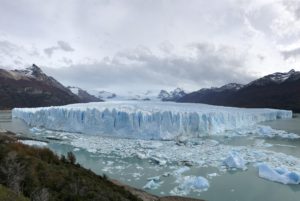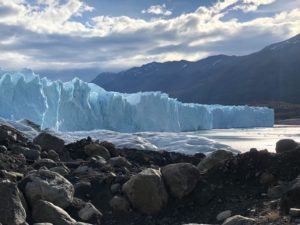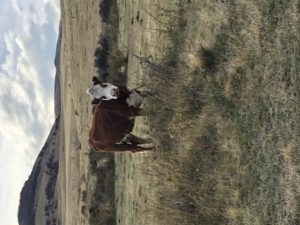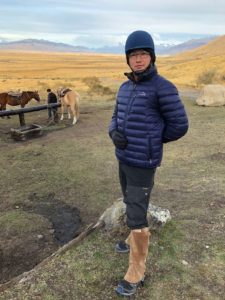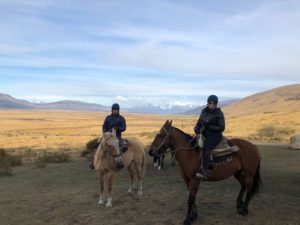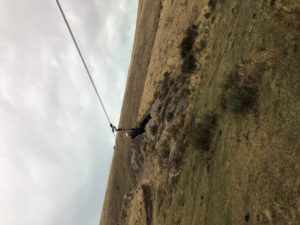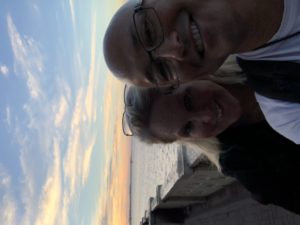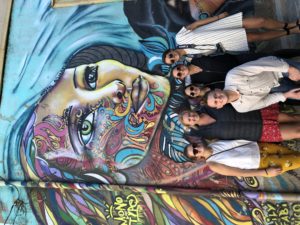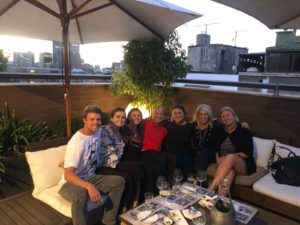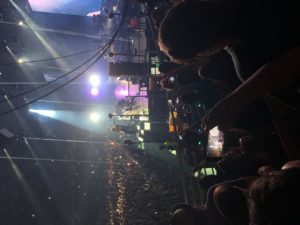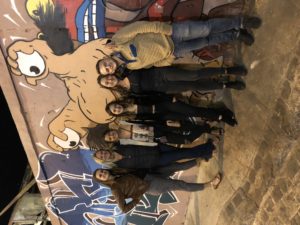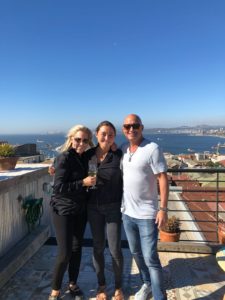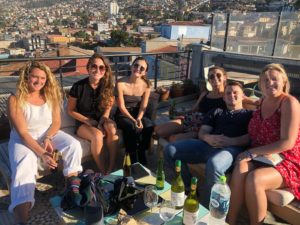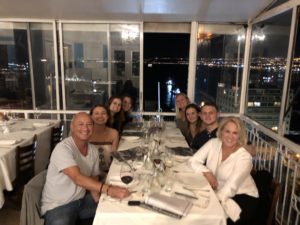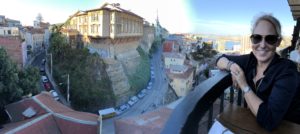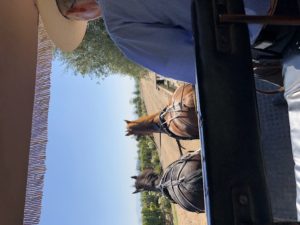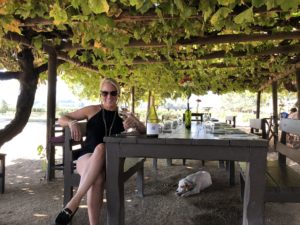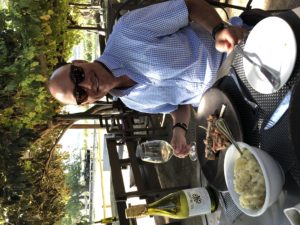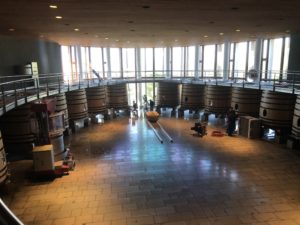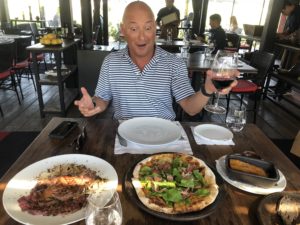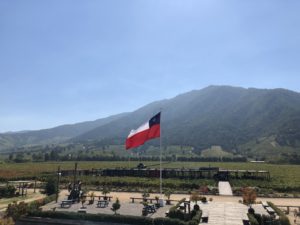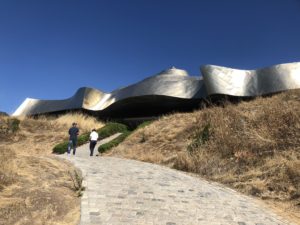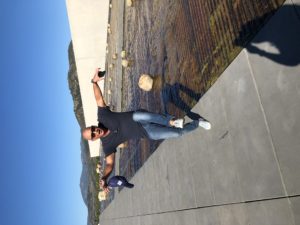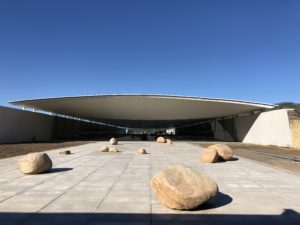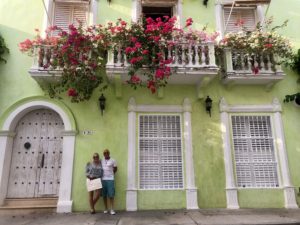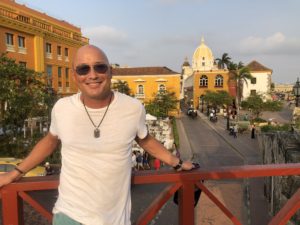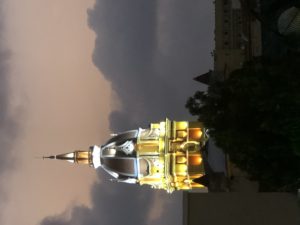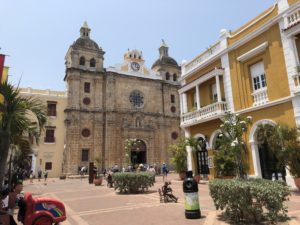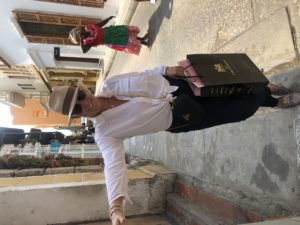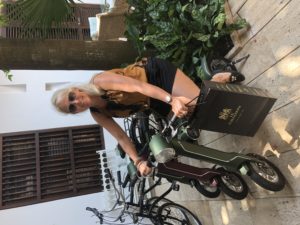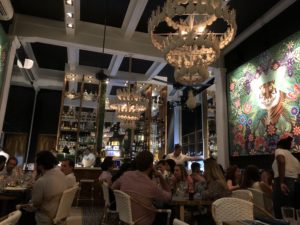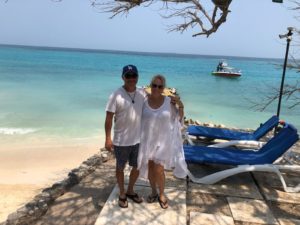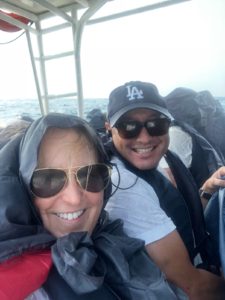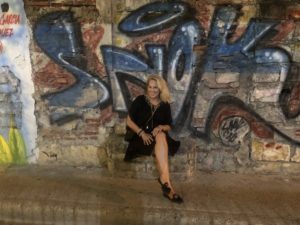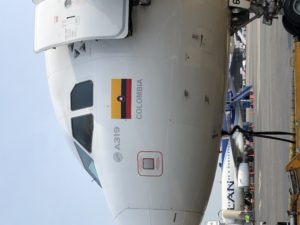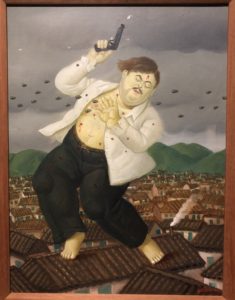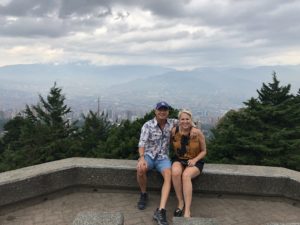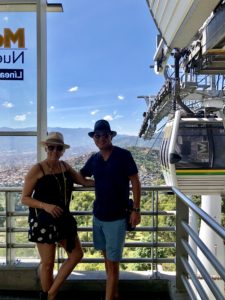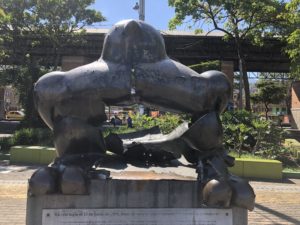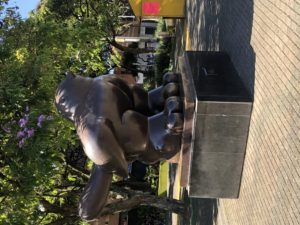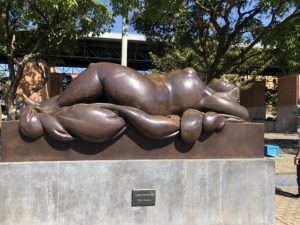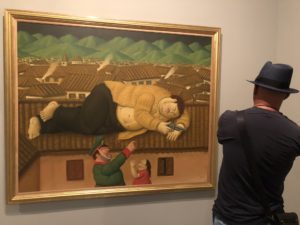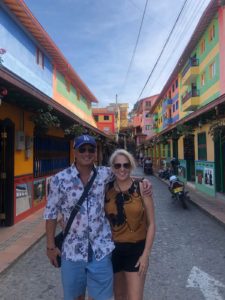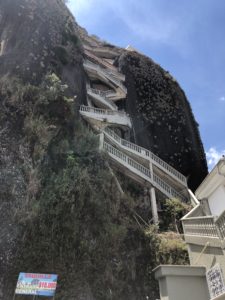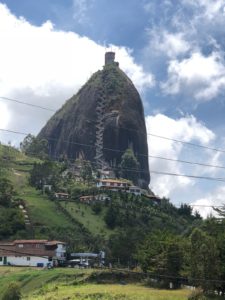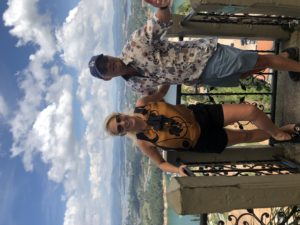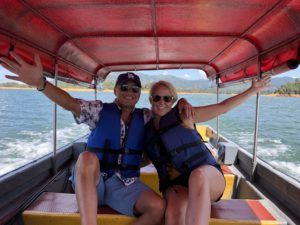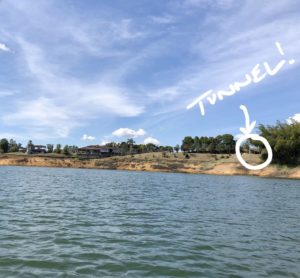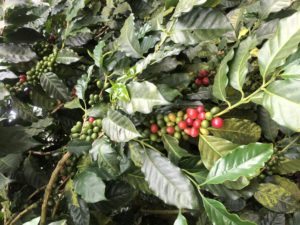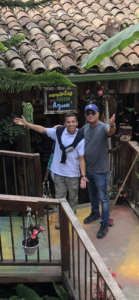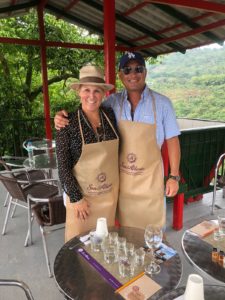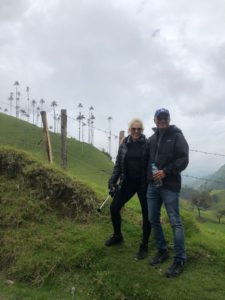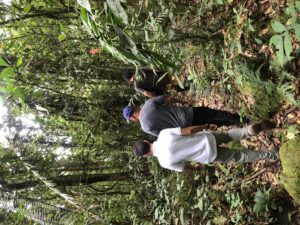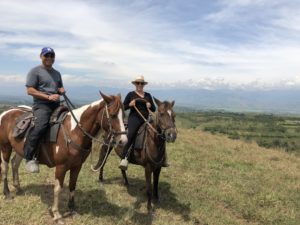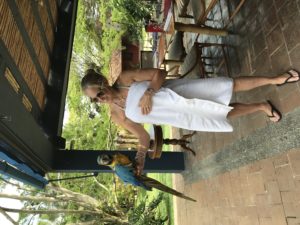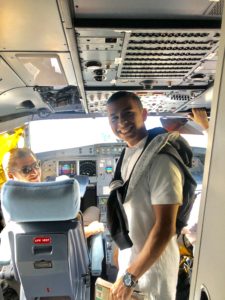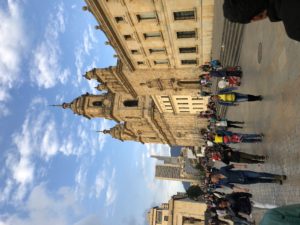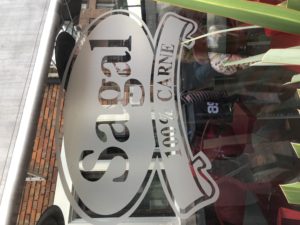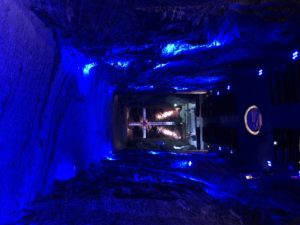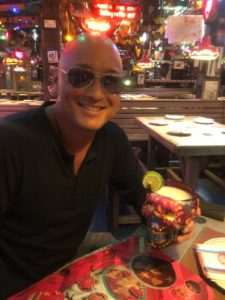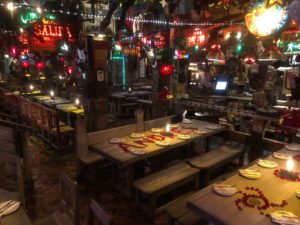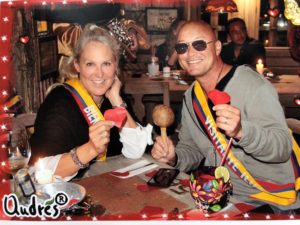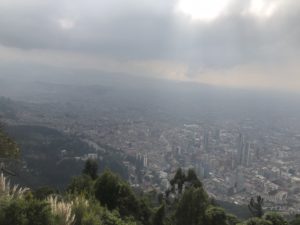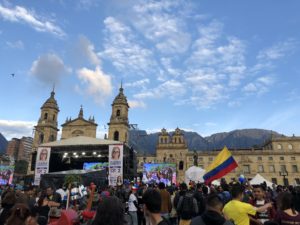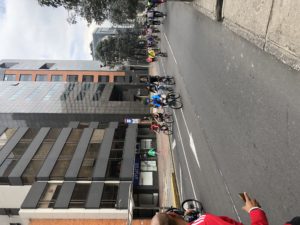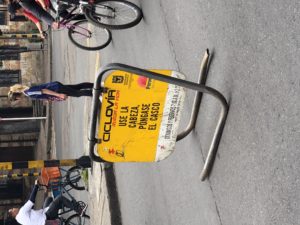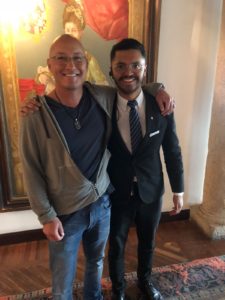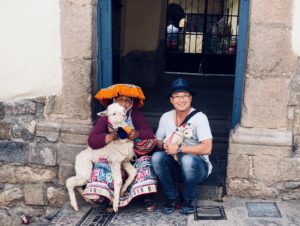
After a harsh 4:30am wake up we catch a 7:00am flight from Santiago to Cusco, Peru – our jumping off point for a trip to Machu Picchu. En route to the hotel, our guide brings us to the Awakancha Center [https://www.tripadvisor.com/Attraction_Review-g294314-d2513725-Reviews-or10-Awana_Kancha-Cusco_Cusco_Region.html] – an alpaca farm and weaving center. Alpacas are a big deal in Peru. And so are traditional weavers.
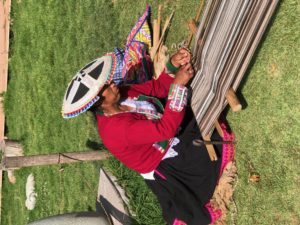
From what we saw, Peru remains a more traditional country than either Chile or Colombia. You see women and children in traditional clothing all the time – and it’s not always for show. It’s really what they wear. It was a cool stop – and I made some new friends too.
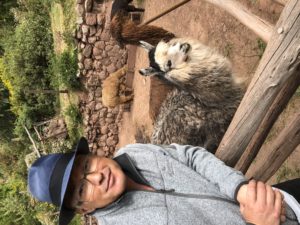
Zoology/textile lesson alert! There are four types of “Camelids” in South America. The llama and the alpaca are domesticated. The guanaco and the vicuña are wild. Wool from the vicuña – very hard to come by – is the most rare. You’ll see scarves made out of vicuña that cost over $6,000 (yes that is US dollars!). You know Mike Dreyfus will get one now that he knows about it. Baby alpaca – which is wool from the first time an alpaca is sheared at 8 months – is also extremely soft and warm and is a super premium fiber used for most of the really nice scarves, hats, shawls, etc. They sell baby alpaca stuff everywhere, but my advice is to purchase these items at the “brand name” boutiques like Sol and Kuna. Otherwise what’s labeled as “baby alpaca” could be more like “maybe alpaca”. That’s my shopping tip for the day.
Our hotel for the next three nights was the fabulous Belmond Rio Sagrado (think that means “sacred river”) [https://www.belmond.com/hotels/south-america/peru/sacred-valley/belmond-hotel-rio-sagrado/?gclid=CjwKCAjww6XXBRByEiwAM-ZUILzAGA2vRIA-2bcDQIvJtni3YCMn4GuMhPOyLOSTdXhLOAuVmNad6hoC3EgQAvD_BwE]. This is a photo – which doesn’t really capture the true magic of the place, but I include it because its the first picture I took from the drone 🤗 I just bought in Santiago. A “Mavic Air” made by “DJI” [https://www.dji.com/mavic-air]. Expect better pictures in the future if I learn to use it before I lose it.
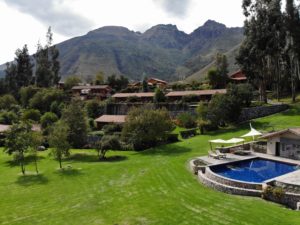
Before getting here, I thought that the only thing to see was Machu Picchu. Actually, there are many, many other Inca settlements that have been preserved and restored and are worth a trip. Honestly though, don’t go see too many cuz after a while they all start to look like another pile of rocks. That’s a joke – sort of. It’s good to have a guide – and a driver. Our guide was Nancy – who happened to be about 8 months pregnant – but she was a trouper climbing up the very steep Inca steps and was full of great info.
First ruins we saw were in the town of Ollantaytambo – the site of one of the major Inca fortresses in the Urubamba Valley. This town is one of the oldest continuously occupied settlements in all of the Americas! There are sixteen massive terraces that you can view from the top – if you climb around 260 big steps. This is the first time that we notice the altitude – which is over 10,000 feet. Very easy for 50-somethings to lose their breath climbing to the top. There are also some massive, perfectly cut stones at the top of the hill which comprise the “Temple of the Sun”. It is incomprehensible to understand how these giant blocks of granite were quarried, transported hundreds of feet straight up and cut to fit together perfectly with no power tools – in fact, no iron tools. (Lack of iron was also a major reason that the Spaniards conquered them in the 1500’s with relative ease).
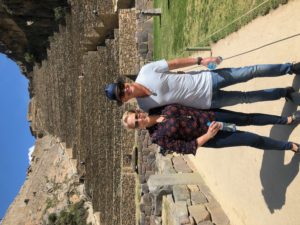
Next up, more ruins called Pisac. A pretty amazing, mind-boggling site. These terraces – like most – were used for farming and comprise a ton of plantable acreage. It’s really noticeable when you see them from above. Pretty incredible engineering by a civilization that did not have a written language.
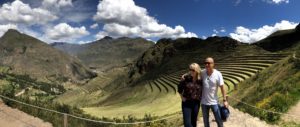
Below the ruins, you’ll find the town of Pisac which is known for its handicraft market where the locals sell their merchandise. I’m guessing you’ll find a lot of “maybe alpaca” here. Seriously though, if you are visiting Cusco later on your trip, understand that pretty much everything will be available there as well and then some…. So, unless you really like cheap tourist stuff, there’s really no need to spend a lot of time here.
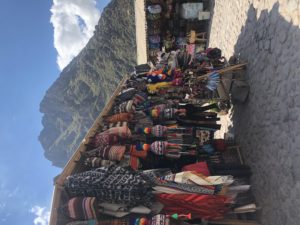
We had a great lunch at Hacienda Huayoccari [https://www.tripadvisor.com/Restaurant_Review-g294317-d2400312-Reviews-Huayoccari_Hacienda_Restaurant-Sacred_Valley_Cusco_Region.html]. This is another one of those places that you’ll never find unless you’ve been there before. And even then, just a 50/50 chance. This place is a private villa that is reserved for cool guided tours – like ours – arranged by high end travel pros like Tammy Cane [http://www.theartoftravelbytammycane.com/about/] Its about a mile up a dirt road from the main highway. A totally unexpected treat. In addition to a great lunch you get to tour a beautiful Spanish home full of colonial art and Inca artifacts.
OK, so this is falls under the category of “a bit weird”. At least to North Americans. One of the great Peruvian delicacies – eaten mainly on special occasions – is roasted guinea pig. We’re told that locals actually raise them in their house and then roast them. This will not be on the menu at Hermosa Beach’s Bottle Inn. After a few glasses of Malbec, I did have one for dinner at the Belmond. Tastes kind of like roasted, mushy duck. Moving on.
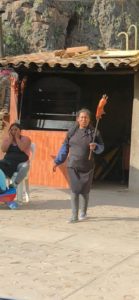
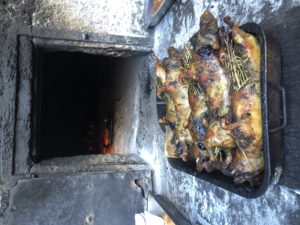
There are a number of ways to get to the actual Machu Picchu citadel. Natalie and her friends took the famous Inca Trail. That involves four days of hiking and sleeping in tents. Two of which are brutal, straight up climbing days.
Shawn and I opted for the Vistadome train. This is a really nice transport. It has big, panoramic windows providing great views and photo ops along the Urubamba River.
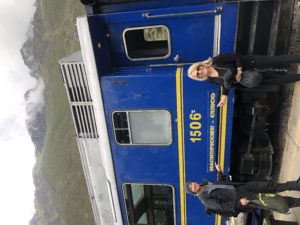
After about 90 minutes we arrive in the town of Aguas Calientes where we board a bus to Machu Picchu.
I think you need two days to properly do Machu Picchu. The first day it’s good to have a guide help provide context to what you’re seeing. We learned it was built by the Inca’s in about the 15th and 16th centuries. No one really knows why it was built or what it was used for. Similarly, no one knows what the place was even called – Machu Picchu is actually the name of the mountain next to the site. Additionally, the entire place was apparently abandoned in the mid-1500’s – during the period that the Spaniards were conquering the Incas – and again, no one really knows why they left. Especially since the Spaniards never found Machu Picchu. So, after soaking up all this knowledge on the first day, it is a good idea to have another day just to walk around by yourself. Even the site’s roaming llamas appreciate the tremendous view.
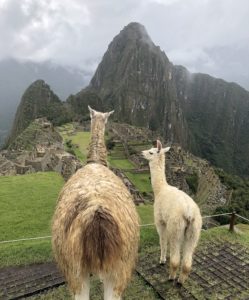
We were fortunate to stay at the Belmond Sanctuary Lodge. It’s the only hotel at the gate to the site so on our second day, we woke up at sunrise for that “once-in-a-lifetime” opportunity to truly experience the full spirituality of the Inca’s greatest achievement. Unfortunately it was totally fogged in and we couldn’t SEE anything.
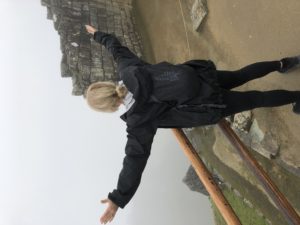
Nonetheless, at a site that can get up to 7,000 visitors a days, it’s pretty magical to have the place pretty much all to yourself for a little while. Shawn took advantage and made some new llama friends.
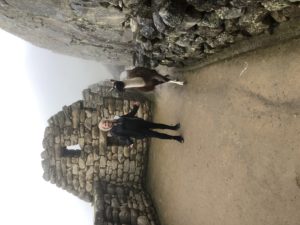
Being early also allow you to be one of the first of the day to hike up Wyanapicchu – the tallest point within the ruins. If you want to do the Wyanapicchu hike – and I recommend it – you need to make a reservation. Only about 400 persons per day are allowed up the trail which gets narrow, steep, difficult – and really high. It takes about two and a half hours – 90 minutes up and about an hour down. It was foggy so we could only see the granite steps and terraces. I have a feeling if it’s clear it gets pretty scary for those with any fear of high places.
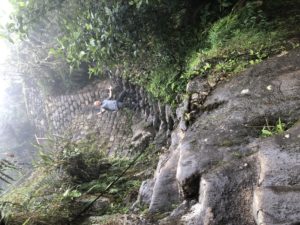
The view from the top is said to be incredible. We would not know since all we could saw was a deep grey bank of cloud. But still very cool. Wyanapicchu is the tall peak in the background of this photo. If you look really close, you can see the terraces and hikers near the peak.
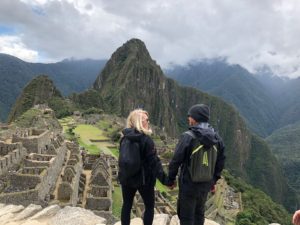
Later that day we made a second hike to the Sun Gate. Still foggy and now rainy. But great. It’s another two hour uphill hike, but if you’re there, is totally worth the effort. Also, you have to remember to bring a rain coat. They don’t allow umbrellas.
After several days of full-on-Inca-immersion, the magic continues. The Hiram Bingham train (named after the discoverer of Machu Picchu) is a must do [https://www.belmond.com/trains/south-america/peru/belmond-hiram-bingham/]. It’s an incredible, fully restored train that feels like it’s right out or a Hitchcock movie. The train takes you back through the Sacred Valley on your return trip to Cusco. Super elegant dinner service and a rocking bar car.
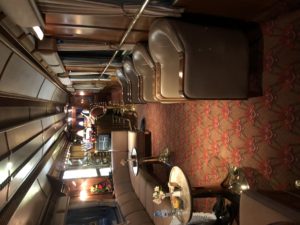
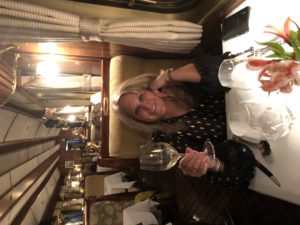
On our trip there was an Asian rapper, complete with a full social media crew – two cameramen and a lighting guy – who freestyled with the Peruvian band. Super fun. Click on the link for a taste of his rap.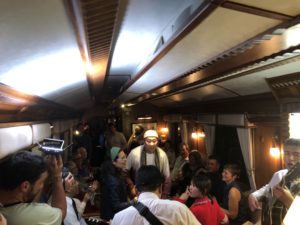
C96EF278-967F-4CE6-BEE4-89BC619631F5
The Hiram Bingham train is not cheap – it’s $500 per person. But it is definitely a one-of-a-kind, memorable experience that really puts a cap on your trip.
Next stop for us was Cusco, the historic center of the Incan world and a place with good restaurants. For logistical reasons, we ended up staying four nights – at least one night and possibly two nights too long. Nevertheless, there are some very cool things to see.
First is the Santo Domingo Temple. This is a Dominican Church and convent built directly on top of the foundations of one of the main Inca temples to the sun. I found it fascinating to actually see how the conquering Spaniards built right on top of their conquered Inca foe.
Next cool site is the huge ruins of a major Incan fortress, Sacsayhuaman (pronounced “sexywoman”). Very cool. Very big and you probably need to take a short cab ride to get there.
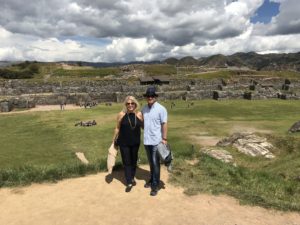
It’s impossible to miss Cusco’s main square, the Plaza de Armas. Here you’ll find a couple of massive cathedrals full of colonial paintings and sculpture from the Cusco School of Art. Cool stuff, but you can probably do it all in two days. Maybe even one.
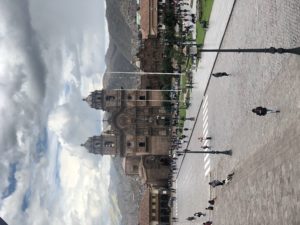
Additionally, there is a ton of shopping. Peru is known for its excellent silver and gold and you’ll find many, many stores selling wonderful products. Also, lots of alpaca goods and local handicrafts. There’s good food too. Of note, the restaurant in the Belmond Montesario hotel [https://www.belmond.com/hotels/south-america/peru/cusco/belmond-hotel-monasterio/]. If you go, make sure it’s opera night. Live music and great food in a hotel in a beautifully restored monastery. If you look hard, you can find the Gurbach’s favorite empanada emporium, Copacabana
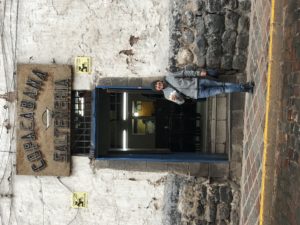
On the way out of Cusco, we had one night in the nation’s capital, Lima. We stayed at the JW Marriott in the fashionable Miraflores section of town. After a great sunset, we had dinner at Osaka, in the upscale San Isidro district which was an excellent recommendation from my friend, and Lima native, Carlo Brignardello. It was superb. If you are in Lima, you must visit. Japanese with a Peruvian flair.
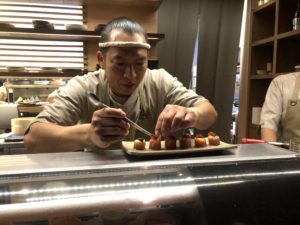
After having been in South America for two months, it’s time to move on. We’ve very much enjoyed our stay on this continent, but very excited for our next stop – Florence, Italy.
